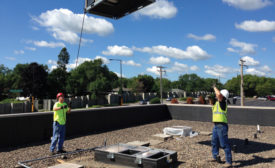Energy Management Features
Organizations express support, concern over parts of the comprehensive energy legislation
Read More
Schneider Electric, City of Tupelo Take on Major Energy Efficiency Project
Will be largest parks and recreation project in the state of Mississippi
December 21, 2015
Motor Technology Drives Circulator Pump Innovation
Variable-speed technology and controls improve pump efficiency, ease of installation
Read More
EnVisioneering Symposium Focuses on Integrated Buildings
Danfoss event highlights future of building integration strategies, efficiency, and technology
Read More
We Built This City on Efficiency
Contractors discuss the regulatory and economic conditions of the cities they represent
Read More
What Will Buildings Look Like in 100 Years?
Government, industry contemplate the future of US structures
Read More
Coalition Amplifies the Mechanical Industry’s Voice in Washington
HPBCCC provides the HVAC industry a collective forum before Congress
Read More
HVAC Industry Invests in Low-GWP Refrigerants
HVACR industry spent more than $255 million in 2015 to research, develop low-GWP refrigerants
Read More
A Quest for Healthy Patients and Hearty Bottom Lines
Contractors help hospitals meet regulations and control costs
Read More
Copyright ©2024. All Rights Reserved BNP Media.
Design, CMS, Hosting & Web Development :: ePublishing








![photo-1430834500855-3873f1e078f5.jpg Buildings of the future will] be able to transact with the grid, know which systems are working, be able to monitor the status of the buildingââ¬â¢s health, and be able to cater to the needs of individuals.](https://www.achrnews.com/ext/resources/2015/11-2015/11-16-2015/photo-1430834500855-3873f1e078f5.jpg?height=168&t=1447341824&width=275)



